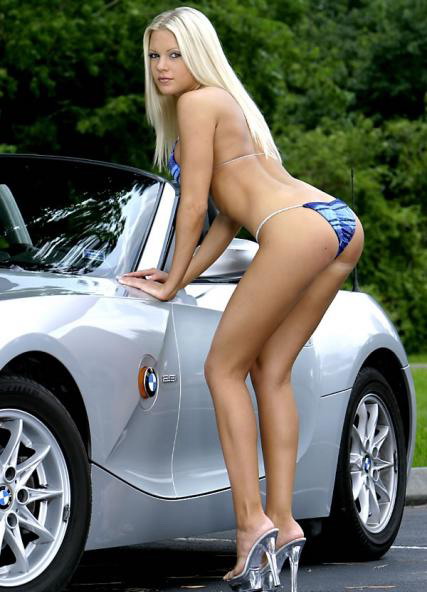
Even five years ago, Hyundai was widely considered to be a bargain-basement marque. After all, anyone interested in checking out the brand's lineup could visit a rental company within five miles of any major airport. But why dwell on the past when the Korean automaker is kicking butt and taking names in the here and now? Hyundai has been on a roll these past few years, with hits like the Genesis, Genesis Coupe and 2011 Sonata. With those successful entries, Hyundai has clearly established itself as a prime player in the U.S. market, but the company's improved standing has also substantially raised the public's levels of expectation. Where qualifiers like "for a Hyundai" were once the norm, we're now measuring each and every new entry donning the italic H against the best from Toyota, Ford, General Motors and Honda.
Hyundai's most recently refreshed product is the 2011 Azera. When the Azera first arrived on U.S. shores as a 2006 model, it came came close to nixing the "for a Hyundai" stigma with an impressive level of standard equipment and a lower price tag than its competition. But even with a strong value equation and plethora of amenities, that original Azera still wasn't as refined as the current crop of winners coming out of South Korea. Can the freshly redesigned 2011 Azera, with an improved powertrain and increased level of luxury equipment, truly succeed like its all-star siblings?
The Azera has received more than a mild refresh for 2011, with a pair of upgraded powertrains, new headlamps, taillamps, fog lights and a host of tweaks and tucks to the front and rear fascias. Our Midnight Blue Limited tester included the only available option, a $1,750 navigation system, nudging the Azera's MSRP to $32,620. That's still about $5,000 fewer greenbacks than a similarly equipped Toyota Avalon or Ford Taurus. A good deal? Perhaps, but competing in the full-size sedan segment means measuring up on more than just price.
When looking over the Azera from the outside, the large sedan's newest features shine brightest, and not just because we're talking head- and taillamps. The Azera's headlights are pretty special, with the LED-encrusted, Audi-like elements begging for attention. The taillamps are pretty snazzy as well, as Hyundai has gone a bit nuts with the light-emitting diodes. The chiseled front grill also impresses, borrowing its basic shape from the Genesis Sedan while going all-in with chrome in a decidedly American manner. We're also fans of the rich, sparkly Midnight Blue paint job, which gives the Azera a welcome touch of class.
While the Azera's updated exterior elements add a touch of freshness, there are still more than enough throwbacks to push it towards the back of the pack visually. Exhibit A: a tall and somewhat awkward greenhouse. Compared to the steeply-raked, coupe-like roofline of the Sonata, the Azera looks as if it were penned by a fan of Oldsmobiles from the 1990s, and it doesn't fare much better against sleek-looking competitors like the Nissan Maxima or Buick LaCrosse.



Given that the Azera underwent just a refresh and not full redesign, we expected the tweaked exterior to fall short of game-changing. But the interior is another matter altogether. Since it's easier to swap out cabin components than re-engineer sheetmetal, refreshed vehicles often receive fairly substantial interior upgrades. Sadly, not so with the Azera. The interior looks essentially unchanged from the outgoing model, save for some aluminum graining on the center console and a low-tech eco indicator that's about as interesting as a check engine light. The Azera's interior wasn't terrible before with a muted cabin, comfortable seats and reasonably high quality materials on the dash, seats and doors. Unfortunately, "good enough" just doesn't cut it in a segment where MSRPs regularly exceed $30,000. The Avalon, LaCrosse and Taurus far outshine the Azera in this regard with better materials, cushier armrests (the Azera's is as soft as diorite) and superior aesthetics all around.
Park a new Sonata next to an Azera and even the optically challenged can see the larger Hyundai offers a far less compelling cabin while commanding a starting price that's several thousand dollars lower. On the high end of the company showroom is the Genesis Sedan – a fair comparison given our tester was within $1,000 of the starting price of Hyundai's Lexus-fighter. The base Genesis and uplevel Azera also share the same basic powertrain and both offer near identical levels of interior volume. The difference, besides the Genesis being driven by its rear wheels and the Azera its fronts, is that the Genesis comes packed to the sunroof with amenities and interior refinement, while the Azera struggles even against the not-long-for-this-world Buick Lucerne. For instance, the sat-nav on the Genesis – a massive, modern-looking system – dwarfs the Azera's seven-inch unit in both size and design.
So the Azera's interior is many meters short of segment leading, but there is some good news under the hood. Remember the part about the Azera and Genesis Sedan sharing the same engine? The Azera Limited's new 3.8-liter V6 churns out 283 horsepower at 6,000 rpm and 263 pound-feet of torque at 4,500 rpm. (Lesser GLS models make do with a 3.3-liter V6 producing 260 hp and 233 lb-ft.). If you're thinking that the 3.8-liter provides a lot of pop for a sedan driven by its front wheels, you're right – particularly if you're slamming the go pedal from a dead stop. While bull riders would love that level of torque steer, we're less inclined to saddle up. But when you're already in motion, the extra punch is very welcome, and as an added bonus sounds damn good from the driver's seat.
When mated to its new, smooth-shifting six-speed automatic transmission, the revised Lambda 3.8-liter V6 proves is very competent and impressively smooth – easily the best attribute the Azera has to offer. And all that power doesn't kill you at the pump, as the EPA rates the 3.8-liter V6-powered Azera at 27 miles per gallon on the highway and 19 mpg around town. We managed to average just under 22 mpg, mostly because we were "fully experiencing" the 3.8-liter engine.

Dynamically, the Azera is competent for a vehicle that tips the scales at 3,585 pounds. Beyond its torque steer problem, Hyundai has managed to tie down the chassis to the extent that it doesn't offend an elderly buyer looking for a smooth ride. Body roll stays within an acceptable range, though our tester's 235/55VR17 Michelin rubber emitted predictably high levels of tire squeal when pushed. Steering was a bit heavier than we found at the helm of the similarly sized Avalon – generally a good thing – though any semblance of feel went undetected by our paws. Overall, the Azera feels just about how we'd expect a large family sedan to drive – not as tight as the Maxima and not as loose as the Avalon.
So we've established that the Azera shouldn't waste the application fee for any beauty contests, its interior could use some love and its powertrain is a strong suit. Is that enough to propel Hyundai's updated sedan past the "for a Hyundai" designation? In a word, no. Truth is, the competition from Toyota, Buick, Nissan and Ford has it all over the Azera in most every way. The closest the Azera comes to sniffing the winner's circle is with the Limited's excellent V6 engine, but this segment is chock-full of competent powertrains. And we'd argue that "for a Hyundai" isn't even fair to the marque's other products. Is it as good as a Sonata? The Genesis? No.

So why has Hyundai decided to let it hang around? Even though it's been a slow seller, we hear that Hyundai has kept the Azera in its lineup for buyers who come in to sample the Sonata, only to walk away because its styling is too avant-garde. If that's the strategy at work, it also neatly explains the visual conservatization brought about with the car's 2011 facelift. Said another way, the Azera remains as a hedge bet for keeping elderly and more traditionally minded customers in the fold who are looking for comfortable full-size transportation with a good warranty. By that yardstick, it succeeds – but only just. In 2006, we would have called the Azera competent, affordable and perhaps even a bit surprising, but it's 2010, and these days we expect more.








































